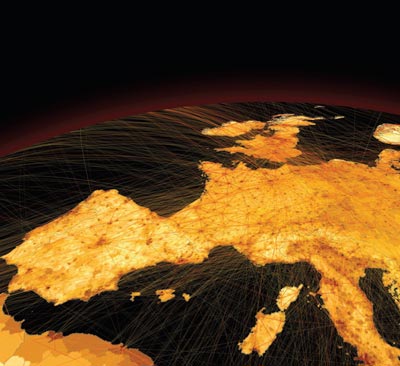
Predicting epidemic spread based on transport networks (Courtesy: B Goncalves et al., Indiana University)
By James Dacey
So it’s my second day here in Torino at the Euroscience Open Forum and I’ve just about got my bearings now, helped by forking out five euros to take the “panoramic elevator” to the top of the city’s National Museum of Cinema where I was treated to a fantastic view over the city and the surrounding Alps.
As its name suggests this conference is all about scientists and science communicators coming together from across the continent to discuss their research and can apply their discoveries to the real world.
Naturally I am interested in the way physics fits into all of this and to suss out what particular research fields are coming into bloom.
The thing that has struck me so far is the way physics and mathematics are now really starting to stretch beyond their traditional academic boundaries to interact with other more “human” research domains that were previously considered off-limits.
For instance, I saw a fascinating talk yesterday afternoon about how stochastic models could be applied to cancer treatment to model the spread of the disease and ways to optimize the delivery of drugs. After the talk I caught up with one of the speakers, Jean Clairambault of France’s National Institute for Research in Computer Science and Control, who told me his vision to find a way of personalizing drug treatments to reflect patients’ genetic differences.
Another area where physical models are being applied to the human sciences is to study the movement of people and things across the globe. This topic was discussed this morning in a session dedicated to these “complex networks”, which include the flow of people along transport networks and the flow of money across the US.
This idea of modelling human-interest systems as complex networks has been knocking around for quite a few years now, but early research only looked at evolving processes retrospectively. It was interesting, therefore, to hear Dirk Brockmann of Northwestern University describe how these tools were used for the first time last year as a way of predicting behaviour – in the spread of the H1N1 flu pandemic. Indeed, you can read about this particular research in this special Physics World feature.
Right, all this talk of networking – I should probably go do some myself. Where was that free stall again??



